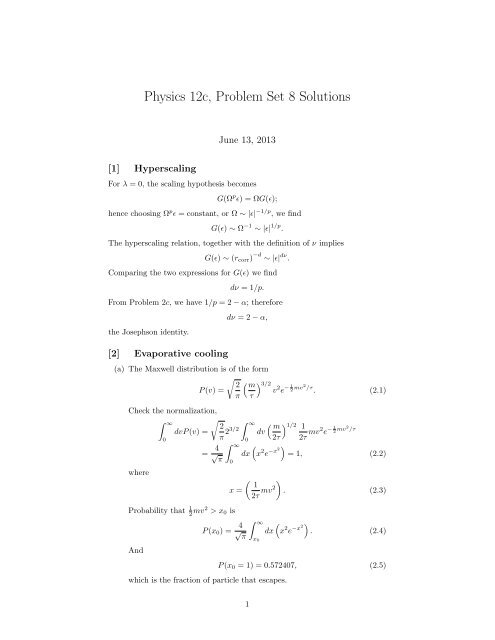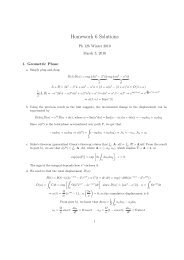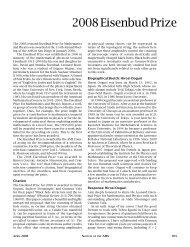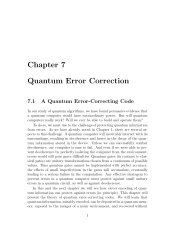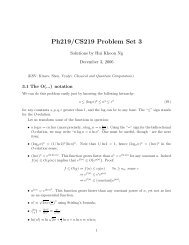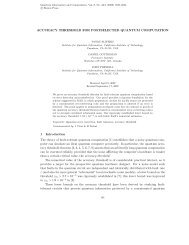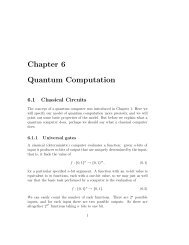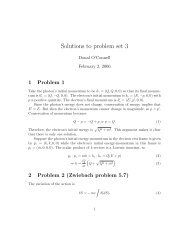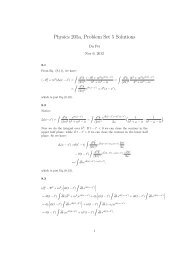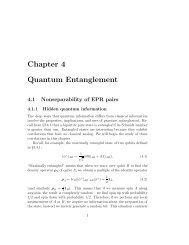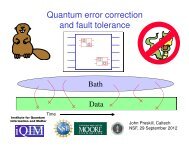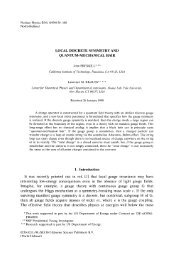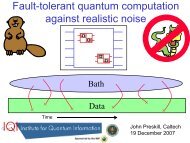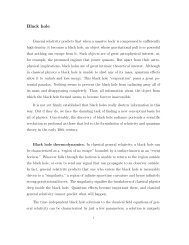Physics 12c, Problem Set 8 Solutions - Caltech Theoretical Particle ...
Physics 12c, Problem Set 8 Solutions - Caltech Theoretical Particle ...
Physics 12c, Problem Set 8 Solutions - Caltech Theoretical Particle ...
You also want an ePaper? Increase the reach of your titles
YUMPU automatically turns print PDFs into web optimized ePapers that Google loves.
<strong>Physics</strong> <strong>12c</strong>, <strong>Problem</strong> <strong>Set</strong> 8 <strong>Solutions</strong><br />
June 13, 2013<br />
[1] Hyperscaling<br />
For λ = 0, the scaling hypothesis becomes<br />
G(Ω p ɛ) = ΩG(ɛ);<br />
hence choosing Ω p ɛ = constant, or Ω ∼ |ɛ| −1/p , we find<br />
G(ɛ) ∼ Ω −1 ∼ |ɛ| 1/p .<br />
The hyperscaling relation, together with the definition of ν implies<br />
G(ɛ) ∼ (r corr ) −d ∼ |ɛ| dν .<br />
Comparing the two expressions for G(ɛ) we find<br />
dν = 1/p.<br />
From <strong>Problem</strong> 2c, we have 1/p = 2 − α; therefore<br />
the Josephson identity.<br />
[2] Evaporative cooling<br />
dν = 2 − α,<br />
(a) The Maxwell distribution is of the form<br />
√<br />
2<br />
( m<br />
) 3/2<br />
P (v) =<br />
v 2 e − 1 2 mv2 /τ . (2.1)<br />
π τ<br />
Check the normalization,<br />
∫ ∞<br />
√ ∫ 2 ∞<br />
dvP (v) =<br />
π 23/2<br />
where<br />
0<br />
0<br />
= √ 4 ∫ ∞<br />
dx π<br />
Probability that 1 2 mv2 > x 0 is<br />
And<br />
0<br />
x =<br />
P (x 0 ) = √ 4 ∫ ∞<br />
π<br />
which is the fraction of particle that escapes.<br />
( m<br />
) 1/2 1<br />
dv<br />
2τ 2τ mv2 e − 1 2 mv2 /τ<br />
(<br />
x 2 e −x2) = 1, (2.2)<br />
( 1<br />
2τ mv2 )<br />
. (2.3)<br />
x 0<br />
(<br />
dx x 2 e −x2) . (2.4)<br />
P (x 0 = 1) = 0.572407, (2.5)<br />
1
(b) Number of particles with speed in (v, v + dv) is NP (v)dv, carrying energy<br />
1<br />
2 mv2 NP (v)dv. Total energy is<br />
U = N<br />
∫ ∞<br />
0<br />
dvP (v) 1 2 mv2 = Nτ √ 4 ∫ ∞<br />
π<br />
Eenrgy of particles with 1<br />
2τ mv2 > x 0 is<br />
U(x 0 ) = Nτ 4 √ π<br />
∫ ∞<br />
where g(x 0 ) is fraction of energy lost.<br />
(c) The remaining particles have energy<br />
0<br />
dxx 4 e −x2 = 3 Nτ. (2.6)<br />
2<br />
x 0<br />
dxx 4 e −x2 = 3 2 Nτg(x 0), (2.7)<br />
g(1) = 0.849145 (2.8)<br />
Ū = (1 − g)U = (1 − g) 3 Nτ. (2.9)<br />
2<br />
After evaporation,<br />
¯N = (1 − f)N (2.10)<br />
Ū = (1 − g) 3 2 Nτ = 3 2 ¯N ¯τ = 3 (1 − f)N ¯τ. (2.11)<br />
2<br />
So,<br />
for x 0 = 1.<br />
¯τ = 1 − g τ = 0.3528τ, (2.12)<br />
1 − f<br />
[3] Einstein relation on a lattice<br />
(a)<br />
So,<br />
Γ(s → s + 1)<br />
Γ(s + 1 → s) = eF ∆/τ . (3.13)<br />
And,<br />
P R =<br />
P R<br />
= e F ∆/τ →<br />
P L<br />
∆/τ<br />
eF<br />
1 + e , P 1<br />
F ∆/τ L = . (3.14)<br />
1 + eF ∆/τ<br />
P R − P L = eF ∆/τ ( )<br />
− 1 F ∆<br />
e F ∆/τ + 1 = tanh . (3.15)<br />
2τ<br />
(b) For F ∆<br />
τ<br />
[4] Einstein relation from linear response theory<br />
(a)<br />
Z 0 = ∑ a<br />
e −Ea/τ (4.18)<br />
and<br />
Z λ = ∑ a<br />
e −(ɛa−λAa)/τ ∼ Z 0 + λ τ Z 0 < A > . (4.19)<br />
And we know that<br />
Therefore,<br />
∑<br />
B a e −(ɛa−λAa)/τ ∼ Z 0 < B > + λ τ Z 0 < AB > . (4.20)<br />
a<br />
< B > λ<br />
Z 0 < B > + λ τ Z 0 < AB ><br />
Z 0 + λ τ Z 0 < A ><br />
∼< B > 0 + λ τ (< AB > 0 − < A > 0 < B > 0 ).<br />
(4.21)<br />
(b) Next consider H → H−F x. Find drift velocity < v > F , where < v > 0 = 0.<br />
< v > F = F τ < vx > 0 (4.22)<br />
[5] The cost of erasure<br />
(a) According to Boltzmann distribution, the probability is proportional to<br />
e −E/τ . Thus, we have<br />
1<br />
P (0) =<br />
(5.23)<br />
1 + e −λ/τ<br />
(b)<br />
(c)<br />
W =<br />
∫ ∞<br />
0<br />
P (1) =<br />
e−λ/τ<br />
1 + e −λ/τ (5.24)<br />
dW = P (0)dE 0 + P (1)dE 1 (5.25)<br />
dW =<br />
dW =<br />
e−λ/τ<br />
dλ (5.26)<br />
1 + e−λ/τ ∫ ∞<br />
The result agrees with the Landauer’s Principle.<br />
0<br />
e −λ/τ<br />
dλ = τ ln 2 (5.27)<br />
1 + e−λ/τ 3


